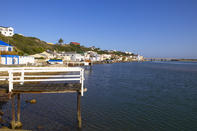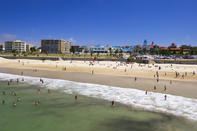The City on the Bay
P.E. "Port Elizabeth" goes by many names: The Friendly City, the Windy City, the City on the Bay, the Nelson Mandela Metropolitan Area. Whatever you call it, P.E. is a lekker place. It’s not humid like Durban. It isn’t as posh as Cape Town. The beaches are great. The locals are friendly. The sea’s warm.

So why don’t more people go there? One will never know. Historically, Port Elizabeth goes back a long way. Bartolomeu Dias saw the bay on his momentous journey around the Cape, and named it Bahia de Lagoa, or Lagoon Bay. This was soon corrupted to Algoa Bay, which it remained for a few hundred years, until it was recently renamed Nelson Mandela Bay, for no apparent reason other than to curry favour with the tourists.
Algoa Bay, by the way, should not to be confused with Delagoa Bay, which is the old name for Lourenço Marques, which has now become Maputo, the capital of Mozambique, a country that used to be called Portuguese East Africa. D’you get all that? I tell you, nomenclature is a tricky business in this part of the world.
The Dutch did little to develop the potential of Algoa Bay because the strong summer winds had a habit of driving ships into the rocks. Nevertheless, in time, the Eastern districts of the colony needed a harbour, and Algoa Bay was the only one around.
In 1799, the first British administration built a small outpost, called Fort Frederick, on the banks of the Bakens River mouth, and a small town began to develop. The subsequent Batavian administration then founded a town close to Fort Frederick, which they called Uitenhage.
European Settlers
Once the second British Administration had found its feet, they began to appreciate the value of the little harbour at Algoa Bay, but they were troubled with the on-going friction between white settlers and the native Xhosa tribes living in the vicinity. The British, in their ineffable wisdom, decided that the solution was to build up a buffer zone of European settlers, which would neutralise the threat of any independent tribal authorities.
Undeterred by any thoughts that they may actually be making the problem worse, a campaign of sponsored emigration was launched to attract new settlers from England, Scotland and the other parts of the empire. When this first wave of organised immigration arrived at Algoa Bay in the motley form of the 1820 settlers, the British governor travelled from the Cape to welcome the new arrivals.
This melancholy man, named Sir Rufane Donkin, gave the settlers a rousing speech, welcoming them to their new home. He also decided to re-named the town around Fort Frederick after his dearly departed wife, Elizabeth, who had died of fever two years earlier while the couple were stationed in India. Port Elizabeth became a magistracy in 1825 and, 100 years later, an artificial harbour was built to give the ships an anchorage that was safe from the wind.
Now, Port Elizabeth is one of the largest towns in SA, and the centre of our motor manufacturing industry. It is also the financial capital of the Eastern Cape, and a hotbed of industrial development. In fact, the jewel in the crown of South Africa’s current public works programme is the ambitious, multi-billion rand industrial complex being developed around the nearby port of Coega.
A Major Tourist Centre

Port Elizabeth is more than a big business centre. It is also a major tourist centre. Yes, the main bathing beach might look out over the huge cranes of the harbour, and the shoreline might be littered with thousands of ugly, concrete dolos. But so what? The wide beaches, well-stocked aquarium, flashy casino, beachfront shopping centres and a long, grassy promenade all work together to create the ideal holiday vibe.
Most of the beachside attractions of Port Elizabeth are spread out along Summerstrand but, if you are interested in history, you have to start your explorations in the city centre. Once you get past the network of ugly overpasses that screen the centre of town from the speeding traffic, the Port Elizabeth Central Business District CBD is quite attractive.
The main roads through ‘lower’ town are Baakens Street and Gowan Mbeki Avenue, named after the African National Congress ANC stalwart and father of a former president Thabo. These roads are lined with a strange collection of old churches, art deco office blocks, and monolithic slabs of concrete with repetitive stylistic motifs from the 70’s. The pedestrians buzz along the pavements, and the stores are thronged with people buying clothes, shoes, phone cards and vetkoek.
By David Fleminger